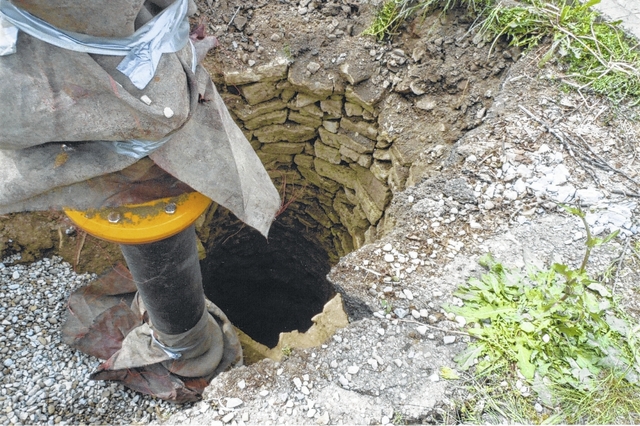

While working on the city of Urbana’s Phase 1 Water Main Replacement Project, employees of Milcon Concrete Inc., Troy, recently made a surprising discovery when they uncovered a well beneath the ground at the northeast corner of East Court and North Locust streets.
“We did not know the well existed, so therefore, its history is unknown to us here at the city,” said city Engineer Tyler Bumbalough, who added the well measured approximately 35 feet deep and 4 feet in diameter. “It was obviously hand dug.”
Jan Ebert, who lives near the well at 209 E. Court St., said the construction crew discovered it while installing a fire hydrant.
“It is obviously from an early time in Urbana’s history,” she said. “Workers and a visitor speculated that it may have been the town well or the site of a water pump in the 19th century.”
Ebert said there is a chance the well was used by the county’s original courthouse, which was a log cabin. While the exact location of the original courthouse is unknown, it’s believed to have been on Court Street, she added.
As for whether the well still contained water, Ebert said, “After dropping a weight down the well, the workers stated they were surprised to learn the well was dry.”
In order to finish installing the fire hydrant, Milcon Concrete employees covered the well.
“Five minutes after a photo (of the well) was taken, the cement mixer arrived,” Ebert said. “Cement and then gravel closed it over.”
Similar discovery
Champaign County Historical Society Curator Dick Virts said approximately six months ago he was approached by a county resident who uncovered an old well on his property just outside city limits.
While Virts declined to reveal the exact location of the well since it’s located on private property, he did say the two wells could be from the same time period, considering both were lined with stone and share the same dimensions, 33 to 35 feet deep with a 4-foot diameter.
In both cases, Virts said, he is led to believe the wells were likely used as “neighborhood” wells considering the amount of work it must have taken to build them.
“This type of well was hard to dig and dangerous,” he said. “My best guess is the stones had to be put in from the top going down as the well was dug.”

